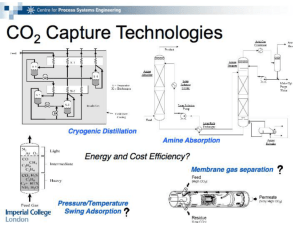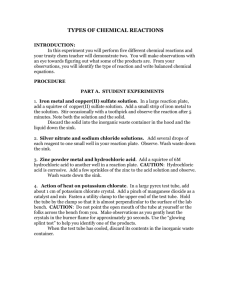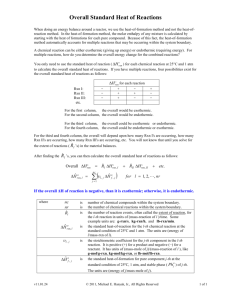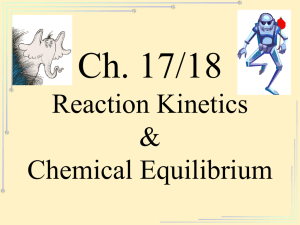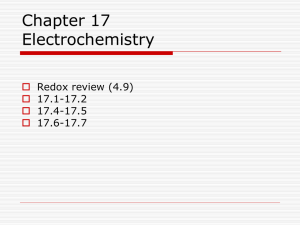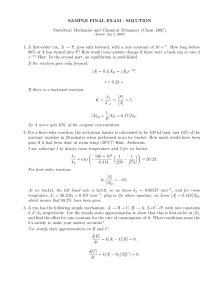rate
advertisement
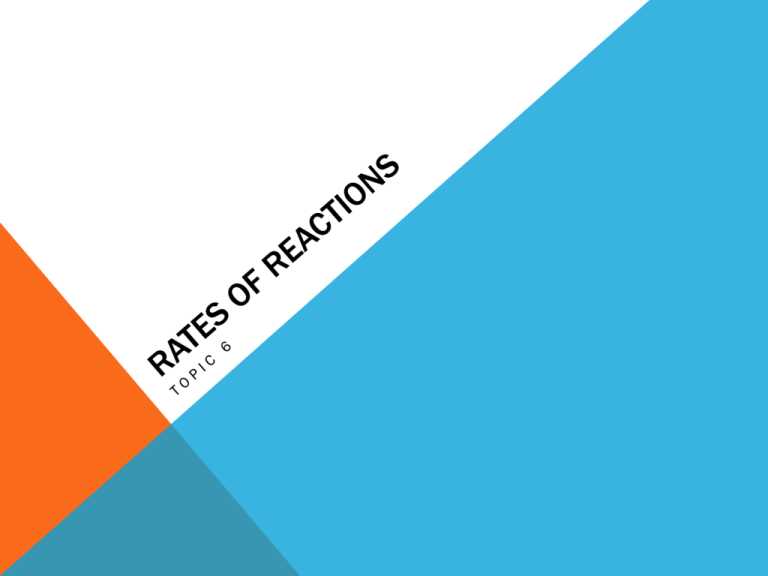
6.1 DETERMINING THE RATE OF A CHEMICAL RXN What is the rate of a chemical rxn? The speed at which reactants are used up and products are formed EXPERIMENTS TO MEASURE RATE OF RXN Consider this rxn: CaCO3(s) + 2HCl(aq) CaCl2(aq) + CO2(g) + H2O We can measure the rate of rxn in 2 ways 1. Measure rate that CO2 is produced 2. Measure the rate at which the mass decreases MEASURING CO2 PRODUCTION CO2(g) Delivery Tube Measuring Cylinder HCl(aq) CaCO3(s) Water MEASUREMENT OF THE RATE MASS DECREASES Mass decreases as CO2 is given off Measure mass decrease every 10 sec Plot the data Cotton Wool HCl(aq) CaCO3(s) Balance RATE OF RXN DEFINED Change in concentration of reactants or products per unit of time (Time could be 1 sec, 1 min, etc) Average rate= (change in concentration)/(time) Unit are dm-3 s-1, dm-3 min-1, etc If a given amount of reactant is used up, the same amount will be produced 6.2 COLLISION THEORY What is the product of particles colliding? Reactions For collisions to result, there are two conditions that must be fulfilled 1. Collision must involve more than a certain minimum amount of energy 2. Molecules must collide with the correct orientations COLLISION MUST INVOLVE A CERTAIN MIN. AMOUNT OF ENERGY To react, particles must collide with sufficient energy The min. energy must result in the activation energy (Ea) Ea is the minimum amount of energy that colliding particles must posses for a collision to result in a rxn If particles collide and do not overcome Ea, they will just bounce off each other Collisions resulting in a reaction are called successful or effective collisions Not all rxns that overcome Ea will result in rxn MOLECULES COLLIDE WITH CORRECT ORIENTATION If molecules do not collide with correct orientation they will not react Main factors affecting rate of rxn 1. Concentration of reactants 2. Pressure for reactions involving gases 3. Surface area of solid reactants 4. Temperature 5. Catalysis EFFECTS OF CONC. Does higher reactant concentrations, how will it effect the rate? With more particles in a given volume, there will be more collisions Increases the chances of successful collisions EFFECTS OF PRESSURE How will increased pressure effect rate? Similar to concentration increase Increases collision frequency Only reactions involving gases are significantly affected by changing pressure EFFECT OF SURFACE AREA OF SOLID REACTANTS Reactions generally only occur on the surface of solids How can surface area of a solid be increase? Finely divide the solid to open up more areas for reactions Allows for more potential collision opportunities RELATIONSHIP BETWEEN TEMP AND THE ENERGY OF PARTICLES IN A GAS How does temp effect the movement of particles? Ideal gas: kinetic energy of the particles in a gas is proportional to its temp in K If temp is doubled, average energy is generally doubled Does not depend on identity of gas, however lighter molecules will be traveling faster than heavier ones EFFECTS OF TEMP ON RATE How does temp effect rate? The rate will generally double for every 10 K increase in temp Why? Collision frequency increases due to particles moving faster The also collide harder Increases the chance for collision MAXWELL-BOLTZMANN Distribution of molecular kinetic energies at a particular temp Only a few particles with high energy and only a few low energy Most particles have average energy CATALYSIS Catalyst A substance that increases the rate of a chemical rxn without itself being used up in the rxn Often written above the yield arrow in the equation Also allow the rxn to proceed by an alternative pathway of lower activation energy May be homogeneous (same state as reactants) or heterogeneous HL2 6.3 THE RATE EXPRESSION Rate equation/ expression Consider A B Rate is directly proportional to [A] Rate= k[A] k is the rate constant The rate expression is experimentally determined equation relating to the rate of rxn to the concentration of substances in the rxn mixture RATE EXPRESSION General equation xA + yB C + D Rate= k[A]m[B]n Rate constant a constant of proportionality relating the concentrations in the experimentally determined rate expression to the rate of the rxn Only constant at a particular temp ORDER OF RXN In respect to a particular reactant is the power of the reactant’s concentration in the experimentally determined rate equation m and n are the orders of the reactants Overall order is m+ n Rate expression can be determined experimentally EXPERIMENTAL DETERMINATION OF RATE EXPRESSION Consider, A + B C The initial rate can be taken because we know the initial concentrations of A and B An experiment with a fixed amount of B and varied concentrations of A is performed Then do the same with fixed A and varied B Use data to determine orders of A and B DETERMINING ORDER OF REACTION AND RATE EXPRESSION FROM EXPERIMENTAL DATA Given the reaction 2A B Experiment [A]/ mol dm-3 Rate/ mol dm-3 s-1 1 2 3 1.0 2.0 5.0 0.60 1.2 3.0 CONT We want to determine: 1. The order with respect to A 2. The rate expression 3. The value of the rate constant (w/ units) 4. The rate of reaction when [A]= 1.3 mol dm-3 ZERO-ORDER RXNS Rate independent of concentration Rate equation is: rate=k Units of k are conc. time-1 Could be mol dm-3 s-1 mol dm-3 h-1 etc. FIRST –ORDER RXNS Rate is directly proportional to the concentration Half- life is first-order Half-life is related to rate constant: rate constant= 0.693/ half-life Rate equation: rate=k[A] Units of k are time-1 SECOND-ORDER RNS Rate of rxn is proportional to concentration squared Rate expression: rate=k[A]2 UNITS OF RATE CONSTANT Overall order Units of k Example of units 0 Concentration time-1 mol dm-3 s-1 1 time-1 s-1 2 Concentration-1 time-1 mol-1 dm3 s-1 3 Concentration-2 time-1 mol-2 dm6 s-1 6.4 THE ARRHENIUS EQUATION Shows the variation of the rate constant with temperature As temp. increases, the rate constant increases exponentially Equation: k=Ae-Ea/RT A pre-exponential factor, A-factor or frequency factor Relates to frequency and orientation of collision A constant that varies slightly with temperature e-Ea/RT the fraction of collision where E> Ea (Energy is greater than activation energy) Not all reactions where E> Ea will result in collision THE OTHER ARRHENIOUS EQUATION May also be written as lnk= (-Ea/R) x (1/T) + lnA This form is used to solve for activation energy, if these procedures are followed 1. Conduct a series of temperature-varied experiments 2. Calculate rate constant for each temp. 3. Plot a graph of lnk (y-axis) vs. 1/T (x-axis) Temp in K Slope = -Ea/R (R= gas constant) EFFECTS OF A CATALYST ON RATE CONSTANT If the rate equation is: rate= k[A][B] Catalyst increases rate constant 6.5 MECHANISMS OF REACTIONS Consider the reaction, 2NO2(g) +F2(g) 2NO2F(g) If this rxn were to occur in a single step, all 3 molecules would have to collide in correct orientation at the same time We could assume that if the concentration was increased the chances of proper collision would increase This makes the rate dependent upon reactant concentrations Rate equation will be: rate= [NO2]2[F2] The 2 superscript comes from the coefficient in the balanced equation CON’T The rate derived from experimentation was found to be rate= [NO2][F2] This suggests that the rxn does not occur in a single step Thus, this reaction (as many more) must occur in multiple steps The chances of molecules colliding in perfect orientation simultaneously is quite low SUGGESTEDMECHANISMS OF THIS RXN NO2 + F2 NO2F +F Step 1 NO2 + F NO2F Step 2 2NO2 + F2 2NO2F Overall Equation Step 1: rate= k1[NO2][F2] Step 2: rate= k2[NO2][F] CON’T Step 1 is the same as the overall equation, thus must be the step determining the rate for the overall rxn Called the rate-determining step (the slow step) Step 2 is the fast step and does not influence the overall rate of rxn to a great extent thus, the concentrations of the step species are not included in the rate equation GENERIC EXAMPLE A + 2B C B+BQ Step 1 rate- determining step Q+AC Step 2 fast Mechanism B+BQ Q+AC 2B + A C Thus, rate= k[B]2 since it is the only species remaining from the first step RATE DETERMINING STEP AS SECOND STEP B + B Q Q+AC Step 1 Step 2 fast rate-determining step Process of determining overall rate is basically the same as if the first step as the slow step Rate= k[Q][A] Because Q is produced by 2 B molecules in the first step, we can replace [Q] with [B]2 Rate= k[B]2[A] ANOTHER MECHANISM A + B S step 1 fast S+BC step 2 rate-determining step Reactants involved up to and including the rate determining step are included in rate equation Rate= k[B]2[A] REACTION INVOLVING A CATALYST CH3COCH3(aq) + I2(aq) CH3COCH2I(aq) + HI(aq) The rxn is acid (H+) catalysed Experimental rate expression is Rate= k[CH3COCH3][H+] Does not include I2, so it is only involved after the rate-determining step CON’T Proposed mechanism: CH3COCH3 + H+ X X + I2 CH3COCH2I + HI + H+ rate-determining step fast Catalyst is involved in the rate- determining step but is regenerated in second step and does not appear in the overall chemical equation X is an intermediate H+ cancels out SN1 VS SN2 MECHANISMS (CH3)3CBr + OH- (CH3)3COH + Br – This is a nucleophilic substitution Experimental rate expression: rate= k[(CH3)3CBr] Since OH- is not included, it is in the fast step Suggested mechanism: (CH3)3CBr (CH3)3C+ + Br – rate- determining step (CH3)3C+ + OH- (CH3)3COH fast CON’T This is considered SN1 S= substitution N= nucelophilic 1= molecularity of rate- determining step Molecularity # of ‘molecules’ that react in a particular step (usually rate-determining) SUMMARY OF MECHANISM RULES 1. Mechanism must agree with overall stoichiometric equation 2. Maximum of 2 particles can react in any one step 3. All species in rate equ. Must appear in mechanism in or before the rate-determining step 4. The power of a particular reactant’s concentration in the rate equ. Indicates the # of times it appears in the mechanism up to and including the rate determining step
